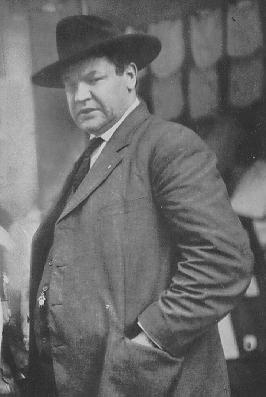William D. “Big Bill” Haywood ranks as one of the foremost and perhaps most feared of America’s labor radicals. Physically imposing with a thunderous voice and almost total disrespect for law, Haywood mobilized unionists, intimidated company bosses, and repeatedly found himself facing prosecution.
Haywood was born in Salt Lake City in 1869, the son of a Pony Express rider who died of pneumonia when Bill was just three. At age nine Bill punctured his right eye with a knife while whittling a slingshot, blinding it for life. (Haywood always turned his head to offer his left profile when photographed, but never replaced his milky, dead eye with a glass one.) Bill was also nine when he first began work in the mines. The 1886 Haymarket riots, trials, and executions made a deep impression on Haywood inspiring, he would later say, his life of radicalism. The Pullman railroad strikes of 1893 further strengthened Haywood’s interest in the labor movement. Then in 1896, while working a silver mine in Idaho, Haywood listened to a speech by Ed Boyce, President of the Western Federation of Miners. Haywood immediately signed up as a WFM member and by 1900 became a member of the organization’s executive board.
When Boyce retired as WFM president in 1902, he recommended Haywood and Charles Moyer assume leadership of the rapidly growing organization. It was not an easy arrangement. Moyer was cautious by nature, favoring negotiations over strikes and violence. Haywood, on the other hand, was volatile, impulsive and inclined toward radical confrontation. Haywood was a powerful speaker and was a master at rallying working class audiences. The campaign for an eight-hour work day became one of Haywood’s principal causes. He would shout, “Eight hours of work, eight hours of play, eight hours of sleep– eight hours a day!”
From 1902 the WFM and the mine operators and government of Colorado were locked in the Colorado Labor Wars, “the closest the United States has ever approached outright class warfare.” The war took 33 lives, including both union and non-union workers. In one single, bloody incident at an Independence, Colorado train depot on June 4, 1904, 13 non-union miners were killed by a powerful explosion as they waited for a train. Haywood was suspected of being behind the explosion, and a virtual open season on unionists ensued.
[In 1905, Heywood was framed by mine owners for the assassination of former Idaho governor Frank Steunenberg]. [Informant Harry] Orchard’s accusation that the Steunenberg assassination was ordered by Haywood led Colorado authorities to arrest him on murder charges in 1906 (Authorities looking to arrest Haywood found him sleeping with his sister-in-law). With time on his hands in the Boise jail, Haywood began to read. Upton Sinclair’s The Jungle, Carlyle’s The French Revolution, were among his selections. While in jail, Haywood also ran for governor of Colorado on the Socialist ticket, designed new WFM posters, and took a correspondence course in law. When a Idaho jury announced its acquittal of Haywood in July, 1907, Haywood jumped to his feet, crying and laughing at the same time. After hugging supporters, he ran to shake hands with each juror.
In 1908, Haywood was ousted… from his executive position with the WFM. Haywood turned his attention to the Industrial Workers of the World (the “Wobblies”). In 1915, Haywood became the formal head of the I.W.W. He led textile strikes in Massachusetts and New Jersey and helped recruit the over three million mine, mill, and factory workers that at one time or another were Wobblies. In 1918, Haywood was convicted of violating a federal espionage and sedition act by calling a strike during wartime. He served a year in Leavenworth, then jumped bond in 1921 while out on appeal. Haywood fled to Moscow where he became a trusted advisor to the new Bolshevik government. Haywood died in Moscow in 1928. Half of his ashes were buried in the Kremlin near his friend John Reed and not far from Lenin’s tomb, an urn containing the other half of his ashes was sent to Chicago and buried near a monument to the Haymarket anarchists who first inspired his life of radicalism.
